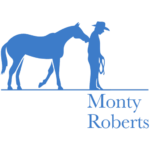Question:
I’m a 23 year old Dutch student and I have been riding since I was 5 years old. I have always followed the conventional methods of the German and Dutch dressage school but since I became familiar with your methods about 7 years ago when visiting a Monty Roberts demonstration, I’ve gone in and out of a kind of existential crisis. I believe firmly in your methods and beliefs, but thinking of them I find it difficult to integrate the Join-Up principles in the dressage school. This has led me to consider a totally different approach to my horse and to abandon dressage in favor of a more natural way of enjoying my mare. But my question to you would be; is my understanding correct? Is it really true that dressage has very little to do with your beliefs? Or could there be a way to combine them both? Since dressage is really all about forcing a horse to assume a posture that isn’t natural and making them do ‘tricks’ and exercises supposedly to train them into assuming a posture that would lead to benefits for the horse. How does Monty see this issue?
Monty’s Answer [Part I of two parts due to the completeness of Monty’s answer]:
A question has come through to me that is very interesting and quite appropriate at this moment in time in the world of horsemanship. The question is ‘can dressage, and the training of dressage horses, be accomplished while staying within the guidelines of your non-violent methods?’ It is my opinion that the one word answer is ‘YES’.
Not for one moment do I want any horseman to believe that the one word answer is actually sufficient. Nothing that we do with horses is so perfect that it requires no revision to make it better for these wonderful animals. Meeting their needs while helping them to become educated to the ways of the human, is absolutely essential.
One should remind oneself that the elements of dressage were born out of pre-historic wars. Each movement can trace its inception to a time when officers rode large athletic horses along with the foot troops on the battle fields of Asia and Europe. All accounts of the training of these horses would suggest high levels of violence.
Carvings in the rocks and later drawings and even the written word would suggest that horses were literally beaten into submission to accomplish elements of dressage that we still see today. These demands are made in riding schools, on bridle paths and most of all in the competition show rings of the world. This is simply not acceptable.
My upbringing was in the western part of the United States. I saw my first dressage horses in the late 1940’s. We had a Hollywood actor, Arthur Godfrey, who went off to Germany, fell in love with dressage and brought two high-level competition horses back to California with him. I was amazed by what these horses could do and observed them intensely.
Later, while studying my behavioral sciences I was able to see several motion picture accounts of the training of these horses. What I saw was appalling. I suppose I immediately checked dressage off my list of acceptable disciplines. It stayed off my list for about five decades. It was then that I met a wonderful Australian lady called Janice Usherwood.
Ms. Usherwood challenged me to observe her techniques for accomplishing world-class pirouettes, piaffe and passage. I have always been one to advise horsemen to keep their minds open and watch for the good things; not dwelling on the bad. Ms. Usherwood called my attention to the fact that I had been operating with a closed mind.
Later I would meet and work with Charlotte Bredahl. She went on to win the bronze medal in dressage at the Barcelona Olympics. Charlotte is a kind lady who loves her horses and would never think of acting out in violence with them. I have come to know her much better in recent years and she has taught me much.
[Part II coming up on Wednesday November 21]

